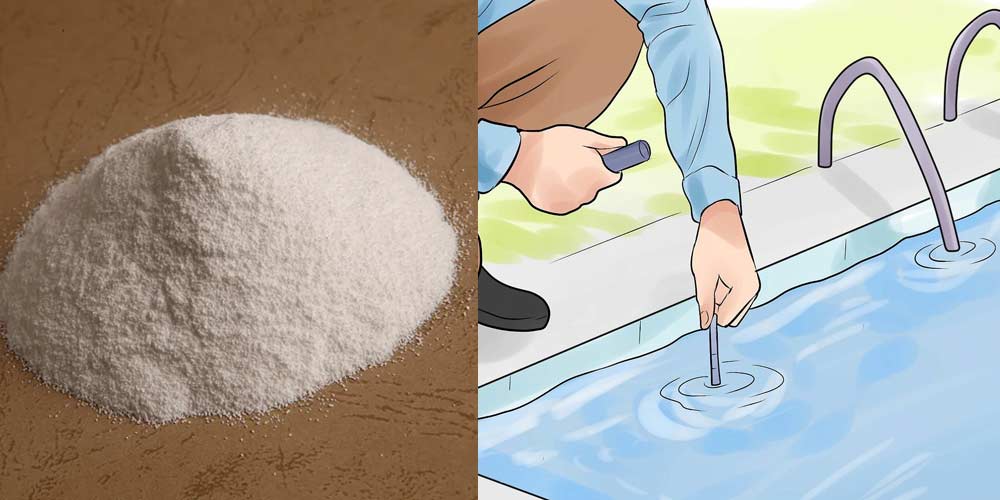Bei der Poolpflege ist es von größter Bedeutung, das Wasser Ihres Schwimmbeckens kristallklar und sicher für Schwimmer zu halten. Ein wichtiger Aspekt dieser Pflege ist die Cyanursäureprüfung. In diesem umfassenden Leitfaden vertiefen wir uns in die Wissenschaft hinter der Cyanursäureprüfung, ihre Bedeutung für die Poolpflege und wie sie Ihnen helfen kann, eine makellose Wasseroase direkt in Ihrem Garten zu erhalten.
Was ist Cyanursäure?
Cyanursäure, oft kurz CYA genannt, ist eine chemische Verbindung, die eine zentrale Rolle in der Chemie des Poolwassers spielt. Sie wird häufig in Außenpools verwendet, um Chlor vor den schädlichen Auswirkungen der UV-Strahlung zu schützen. Ohne ausreichende Cyanursäurekonzentrationen verflüchtigt sich Chlor schnell und ist somit für die Desinfektion des Poolwassers unwirksam.
Die Bedeutung von Cyanursäuretests
Ein korrekter Cyanursäuregehalt ist unerlässlich, um sicherzustellen, dass Ihr Pool hygienisch und sicher für Schwimmer bleibt. Die Prüfung auf Cyanursäure ist aus mehreren Gründen wichtig:
Chlorstabilisierung: Cyanursäure wirkt als Chlorstabilisator. Stabilisiertes Chlor bleibt länger aktiv und sorgt für eine gleichmäßige Desinfektion des Poolwassers.
Kosteneinsparungen: Durch die Aufrechterhaltung angemessener CYA-Werte können Sie auf lange Sicht Geld sparen, da Sie das Chlor nicht so häufig nachfüllen müssen.
Sicherheit: Zu hohe Cyanursäurewerte können zu Chlorblockaden führen, wodurch Chlor weniger wirksam wird. Umgekehrt können extrem niedrige CYA-Werte zu einem schnellen Chlorverlust führen, wodurch Ihr Pool anfällig für schädliche Mikroorganismen wird.
So führen Sie einen Cyanursäuretest durch
Die Durchführung eines Cyanursäuretests ist unkompliziert und viele Poolbesitzer können ihn mit einem Poolwassertest-Kit selbst durchführen. Hier ist eine Schritt-für-Schritt-Anleitung:
Besorgen Sie sich die benötigten Utensilien: Sie benötigen ein Testset für Poolwasser, das Reagenzien zum Testen von Cyanursäure, einen Behälter für die Wasserprobe und eine Farbvergleichstabelle enthält.
Wasserprobe entnehmen: Tauchen Sie den Probenbehälter etwa bis zum Ellenbogen in das Poolwasser, entfernt vom Skimmer und den Rücklaufdüsen. Füllen Sie ihn mit Wasser und achten Sie darauf, die Probe nicht zu verunreinigen.
Reagenz hinzufügen: Befolgen Sie die Anweisungen auf Ihrem Testkit, um das Cyanursäure-Reagenz zur Wasserprobe hinzuzufügen. Normalerweise müssen Sie dazu einige Tropfen hinzufügen und den Behälter schwenken, um die Mischung zu vermischen.
Farbveränderung beobachten: Nach Zugabe des Reagenzes verändert sich die Wasserfarbe. Vergleichen Sie diese Farbe mit der Tabelle in Ihrem Kit, um die Cyanursäurekonzentration in Ihrem Poolwasser zu bestimmen.
Ergebnisse aufzeichnen: Notieren Sie den Messwert und bewahren Sie ihn zur späteren Verwendung auf.
Aufrechterhaltung eines angemessenen Cyanursäurespiegels
Der ideale Cyanursäuregehalt für einen Pool liegt typischerweise im Bereich von 30 bis 50 ppm. Es ist jedoch wichtig, die Herstellerrichtlinien Ihres Pools zu konsultieren oder einen Fachmann um konkrete Empfehlungen zu bitten, da dieser Bereich je nach Faktoren wie Pooltyp und Standort variieren kann.
So halten Sie die richtigen CYA-Werte aufrecht:
Regelmäßige Tests: Testen Sie Ihr Poolwasser mindestens einmal im Monat auf Cyanursäure, oder häufiger, wenn Sie Probleme feststellen.
Bei Bedarf anpassen: Bei zu niedrigen Werten Cyanursäuregranulat oder -tabletten ins Poolwasser geben. Bei zu hohen Werten das Poolwasser durch teilweises Ablassen und anschließendes Neubefüllen verdünnen.
Chlorwerte überwachen: Behalten Sie Ihren Chlorwert im Auge, um sicherzustellen, dass er für die Pooldesinfektion wirksam bleibt.
Zusammenfassend lässt sich sagen, dass die Beherrschung der Cyanursäuremessung ein entscheidender Aspekt für eine effektive Poolpflege ist. Wenn Sie die Rolle der Cyanursäure verstehen und ihre Werte regelmäßig testen und anpassen, können Sie den ganzen Sommer lang einen sicheren und strahlenden Pool genießen. Tauchen Sie ein in die Wissenschaft der Cyanursäuremessung und wagen Sie den Sprung in ein gesünderes und angenehmeres Schwimmerlebnis.
Veröffentlichungszeit: 13. September 2023


